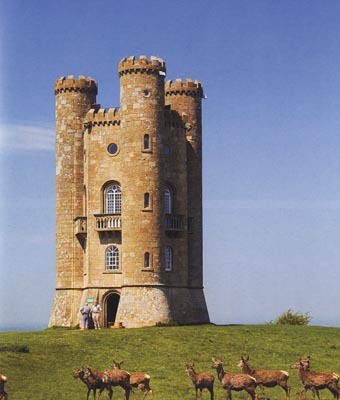Worcestershire is England’s most undervalued county. Sauce, Elgar and cricket, not necessarily in that order, are what most people associate with the name. Otherwise it is that place we cross on our way to Herefordshire, its far smarter western neighbour, or the territory glimpsed on either side of the M5 as we whiz northwards to Birmingham, whose sprawl has chewed up a sizeable part of the ancient shire.
Among those small towns which ‘heritage’ enthusiasts like to claim as a distinctive English speciality, Pershore, Upton and Bewdley must be among the most spectacularly unvisited. Georgian canals, failed spas, even urban schadenfreude, have their buffs and adepts, but which of these ever moseys around the dock basins of Stourport, saunters through Tenbury Wells or pauses for a shudder at Kidderminster’s irredeemable hideousness?
John Betjeman, in a rare moment of imbecility, referred to Worcestershire as ‘dim’. Heaven knows what he meant, since, visually, the whole point about the county is its radiant openness, with broad vistas and big skies. The micro-landscapes within this panorama are embedded in a fascinatingly diverse geology. Patches of medieval forest dot the grey eastern escarpment, a long sandstone ridge to the north-west shelters the hops and cherries of the Teme valley, orchards and market gardens cover the rich alluvial Vale of Evesham, bounded on its southern fringe by the greeny-pink granite crags of the Malvern Hills, once known as ‘the English Alps’.
Something of this variety caught the eye of Nikolaus Pevsner, whose Worcestershire (1968) is among the last volumes in his Buildings of England series. ‘Altogether Worcestershire was conservative,’ he declares of its architecture, noting the persistence of Norman work in the parish churches, the fact that so many of them hung on to their Jacobean pulpits or the way in which ‘the Jones-Pratt-May-Wren style’ took so long to oust stone gables and mullions from the manor houses. He revelled in the wealth of fine funerary monuments, like Edward Stanton’s operatic Russell tomb at Strensham, ‘an almost blasphemous piece of composition’, in the county’s vernacular timber framing among cottages, tithe barns or church towers, and in the fantasy and profusion of its Victorian pleasure domes, from Dawkes’s Italianate Great Witley to Voysey’s Bannut Farm at Castlemorton.
Inevitably the 1968 Pevsner looks like a sketchbook for its glorious new successor. Alan Brooks’s Worcestershire, over twice as long, is a celebration of the county’s impacted riches as much as a sober architectural register. Worcester itself is presented along the lines of a walking-wounded survivor from the horrors of postwar planning, its Tudor and Georgian enchantments preserved alongside such abominations as the 1965 Lychgate Centre, ‘hara-kiri by the City Council, not murder by the architects’. Beside this the cathedral’s restored late medieval exterior seems deceptively bland. Once inside, however, we rejoice in the sturdiness of the Norman crypt, the ‘thrilling verticalism’ of the Lady Chapel with its ‘irresistible excelsior’ of Purbeck marble shafts, and George Gilbert Scott’s lavish 1863 makeover of the choir, complete to the last encaustic tile and gilded railing.
Elsewhere Brooks, while invoking snatches of the original 1968 text, opens doors barred to his predecessor. Holt Castle, whose owner, according to a memorable Pevsner footnote, ‘told me he had thrown my letters straightaway into the waste-paper basket’, now stands revealed (complete with plan) as a nifty 18th-19th-century adaptation of a medieval tower and solar. At Tardebigge, whose name sounds positively Chaucerian — ‘And on hir heed she wore a tardebigge’ — we find a fuller exposition of Hewell Grange, Thomas Garner’s 1884 pink sandstone Jacobethan ‘prodigy house’ for Lord Plymouth. Sadly the ice house reported by Pevsner in the grounds of Strensham Court has now vanished along with the mansion itself but, thanks to fresh research, the building history of Sir John Pakington’s hunting lodge at Westwood, in all its insolent swagger, is now much less mysterious.
Perambulations are more detailed and abundant. Poor, flood-ravaged Upton receives its due as the paradigm of a small Georgian staging post, with its inns, stabling and town houses for the local gentry. At Bromsgrove we pause to deplore the ‘future uncertain’ of the South High School, a clever Sixties modernist compromise, while further north Alvechurch emerges as an absorbing layer cake of Plantagenet borough, canal port and Brummy overspill. As for Malvern, I had better declare an interest. My home town, its impossibly steep declivities transformed by Regency and Victorian architects and engineers into a fusion of Tuscan picturesque (there is even a ‘Bellosguardo’) with Tennyson’s towered Camelot, gets 40 pages’ worth of keenly focused appreciation, down to the very last crocket and cornice on the villas of Graham Road and Lansdowne Crescent.
Not surprisingly, I choose the Brooks-Pevsner Worcestershire as my major book of the year. As a hymn of praise to the county’s enticing variousness and exoticism, it is unsurpassed and, I suspect, unsurpassable. Its bulk, what’s more, makes it ideal for administering a well-aimed thump on the head to all those who would have you believe that the shire contains nothing worth stopping for. ‘Dim’? I don’t think so.






Comments